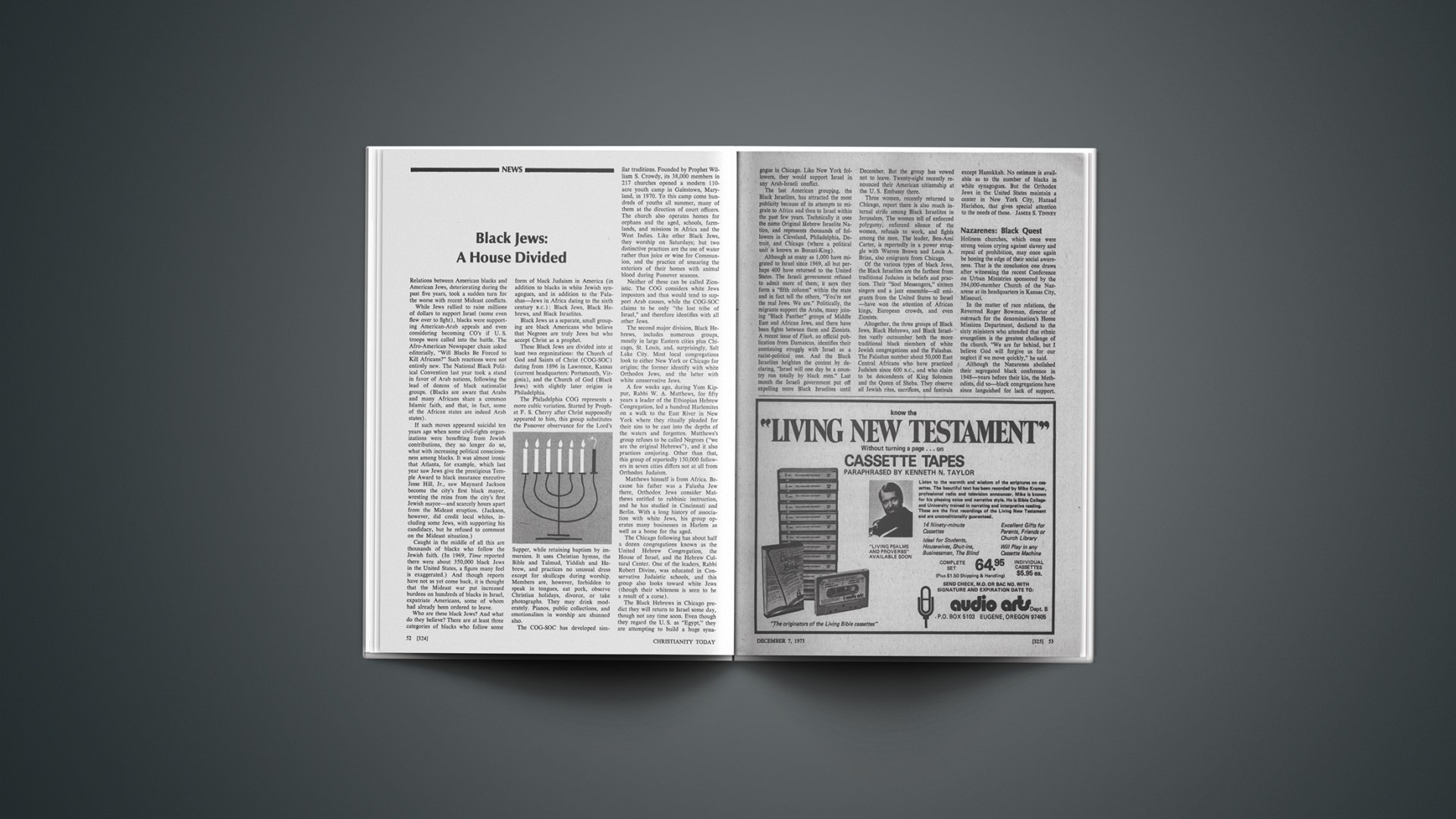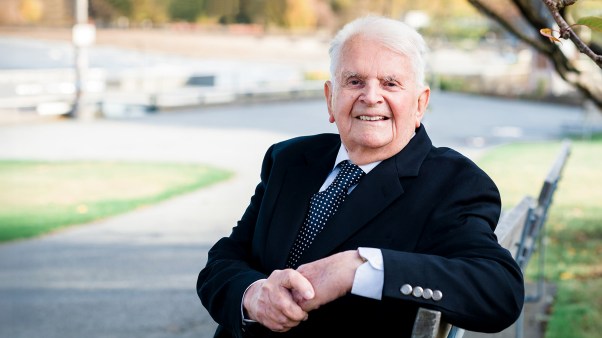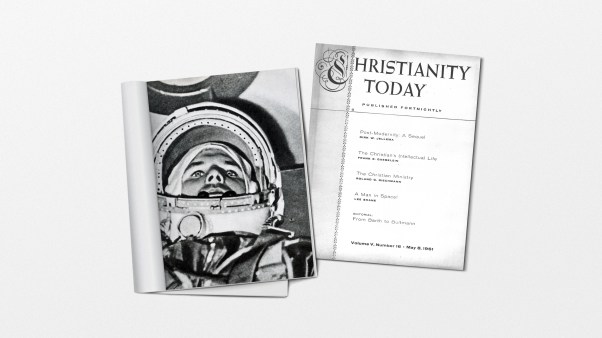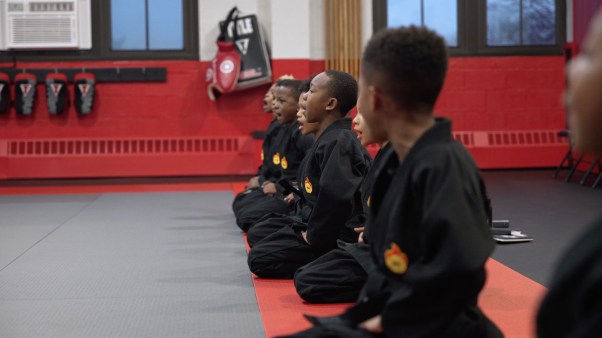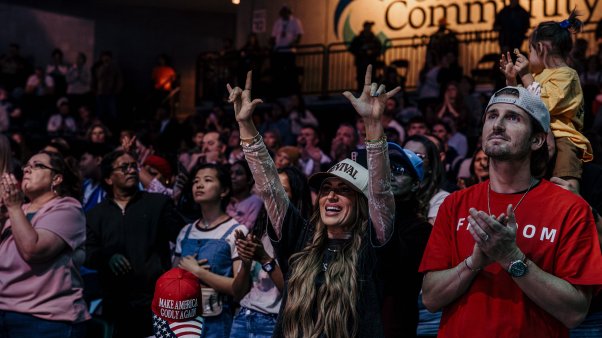Relations between American blacks and American Jews, deteriorating during the past five years, took a sudden turn for the worse with recent Mideast conflicts.
While Jews rallied to raise millions of dollars to support Israel (some even flew over to fight), blacks were supporting American-Arab appeals and even considering becoming CO’s if U. S. troops were called into the battle. The Afro-American Newspaper chain asked editorially, “Will Blacks Be Forced to Kill Africans?” Such reactions were not entirely new. The National Black Political Convention last year took a stand in favor of Arab nations, following the lead of dozens of black nationalist groups. (Blacks are aware that Arabs and many Africans share a common Islamic faith, and that, in fact, some of the African states are indeed Arab states).
If such moves appeared suicidal ten years ago when some civil-rights organizations were benefiting from Jewish contributions, they no longer do so, what with increasing political consciousness among blacks. It was almost ironic that Atlanta, for example, which last year saw Jews give the prestigious Temple Award to black insurance executive Jesse Hill, Jr., saw Maynard Jackson become the city’s first black mayor, wresting the reins from the city’s first Jewish mayor—and scarcely hours apart from the Mideast eruption. (Jackson, however, did credit local whites, including some Jews, with supporting his candidacy, but he refused to comment on the Mideast situation.)
Caught in the middle of all this are thousands of blacks who follow the Jewish faith. (In 1969, Time reported there were about 350,000 black Jews in the United States, a figure many feel is exaggerated.) And though reports have not as yet come back, it is thought that the Mideast war put increased burdens on hundreds of blacks in Israel, expatriate Americans, some of whom had already been ordered to leave.
Who are these black Jews? And what do they believe? There are at least three categories of blacks who follow some form of black Judaism in America (in addition to blacks in white Jewish synagogues, and in addition to the Falashas—Jews in Africa dating to the sixth century b.c.): Black Jews, Black Hebrews, and Black Israelites.
Black Jews as a separate, small grouping are black Americans who believe that Negroes are truly Jews but who accept Christ as a prophet.
These Black Jews are divided into at least two organizations: the Church of God and Saints of Christ (COG-SOC) dating from 1896 in Lawrence, Kansas (current headquarters: Portsmouth, Virginia), and the Church of God (Black Jews) with slightly later origins in Philadelphia.
The Philadelphia COG represents a more cultic variation. Started by Prophet F. S. Cherry after Christ supposedly appeared to him, this group substitutes the Passover observance for the Lord’s Supper, while retaining baptism by immersion. It uses Christian hymns, the Bible and Talmud, Yiddish and Hebrew, and practices no unusual dress except for skullcaps during worship. Members are, however, forbidden to speak in tongues, eat pork, observe Christian holidays, divorce, or take photographs. They may drink moderately. Pianos, public collections, and emotionalism in worship are shunned also.
The COG-SOC has developed similar traditions. Founded by Prophet William S. Crowdy, its 38,000 members in 217 churches opened a modern 110-acre youth camp in Galestown, Maryland, in 1970. To this camp come hundreds of youths all summer, many of them at the direction of court officers. The church also operates homes for orphans and the aged, schools, farmlands, and missions in Africa and the West Indies. Like other Black Jews, they worship on Saturdays; but two distinctive practices are the use of water rather than juice or wine for Communion, and the practice of smearing the exteriors of their homes with animal blood during Passover seasons.
Neither of these can be called Zionistic. The COG considers white Jews impostors and thus would tend to support Arab causes, while the COG-SOC claims to be only “the lost tribe of Israel,” and therefore identifies with all other Jews.
The second major division, Black Hebrews, includes numerous groups, mostly in large Eastern cities plus Chicago, St. Louis, and, surprisingly, Salt Lake City. Most local congregations look to either New York or Chicago for origins; the former identify with white Orthodox Jews, and the latter with white conservative Jews.
A few weeks ago, during Yom Kippur, Rabbi W. A. Matthews, for fifty years a leader of the Ethiopian Hebrew Congregation, led a hundred Harlemites on a walk to the East River in New York where they ritually pleaded for their sins to be cast into the depths of the waters and forgotten. Matthews’s group refuses to be called Negroes (“we are the original Hebrews”), and it also practices conjuring. Other than that, this group of reportedly 150,000 followers in seven cities differs not at all from Orthodox Judaism.
Matthews himself is from Africa. Because his father was a Falasha Jew there, Orthodox Jews consider Matthews entitled to rabbinic instruction, and he has studied in Cincinnati and Berlin. With a long history of association with white Jews, his group operates many businesses in Harlem as well as a home for the aged.
The Chicago following has about half a dozen congregations known as the United Hebrew Congregation, the House of Israel, and the Hebrew Cultural Center. One of the leaders, Rabbi Robert Divine, was educated in Conservative Judaistic schools, and this group also looks toward white Jews (though their whiteness is seen to be a result of a curse).
The Black Hebrews in Chicago predict they will return to Israel some day, though not any time soon. Even though they regard the U. S. as “Egypt,” they are attempting to build a huge synagogue in Chicago. Like New York followers, they would support Israel in any Arab-Israeli conflict.
The last American grouping, the Black Israelites, has attracted the most publicity because of its attempts to migrate to Africa and then to Israel within the past few years. Technically it uses the name Original Hebrew Israelite Nation, and represents thousands of followers in Cleveland, Philadelphia, Detroit, and Chicago (where a political unit is known as Bonazi-King).
Although as many as 1,000 have migrated to Israel since 1969, all but perhaps 400 have returned to the United States. The Israeli government refused to admit more of them; it says they form a “fifth column” within the state and in fact tell the others, “You’re not the real Jews. We are.” Politically, the migrants support the Arabs, many joining “Black Panther” groups of Middle East and African Jews, and there have been fights between them and Zionists. A recent issue of Flash, an official publication from Damascus, identifies their continuing struggle with Israel as a racist-political one. And the Black Israelites heighten the contest by declaring, “Israel will one day be a country run totally by black men.” Last month the Israeli government put off expelling more Black Israelites until December. But the group has vowed not to leave. Twenty-eight recently renounced their American citizenship at the U. S. Embassy there.
Three women, recently returned to Chicago, report there is also much internal strife among Black Israelites in Jerusalem. The women tell of enforced polygamy, enforced silence of the women, refusals to work, and fights among the men. The leader, Ben-Ami Carter, is reportedly in a power struggle with Warren Brown and Louis A. Brian, also emigrants from Chicago.
Of the various types of black Jews, the Black Israelites are the farthest from traditional Judaism in beliefs and practices. Their “Soul Messengers,” sixteen singers and a jazz ensemble—all emigrants from the United States to Israel—have won the attention of African kings, European crowds, and even Zionists.
Altogether, the three groups of Black Jews, Black Hebrews, and Black Israelites vastly outnumber both the more traditional black members of white Jewish congregations and the Falashas. The Falashas number about 50,000 East Central Africans who have practiced Judaism since 600 B.C., and who claim to be descendents of King Solomon and the Queen of Sheba. They observe all Jewish rites, sacrifices, and festivals except Hanukkah. No estimate is available as to the number of blacks in white synagogues. But the Orthodox Jews in the United States maintain a center in New York City, Hazaad Harishon, that gives special attention to the needs of these.
Nazarenes: Black Quest
Holiness churches, which once were strong voices crying against slavery and repeal of prohibition, may once again be honing the edge of their social awareness. That is the conclusion one draws after witnessing the recent Conference on Urban Ministries sponsored by the 394,000-member Church of the Nazarene at its headquarters in Kansas City, Missouri.
In the matter of race relations, the Reverend Roger Bowman, director of outreach for the denomination’s Home Missions Department, declared to the sixty ministers who attended that ethnic evangelism is the greatest challenge of the church. “We are far behind, but I believe God will forgive us for our neglect if we move quickly,” he said.
Although the Nazarenes abolished their segregated black conference in 1948—years before their kin, the Methodists, did so—black congregations have since languished for lack of support. There are now fifty-eight black Nazarene churches, actually fewer than there once were. And only around 300 of the denomination’s 4,654 churches have blacks attending. But that may change under Bowman, who recently became the first black to serve in a Nazarene administrative post. In 1974 he will conduct conferences on interracial evangelism across the nation for the Nazarenes. “Whites can win blacks, and blacks can win whites,” he believes.
JAMES S. TINNEY
Religious America
Religion has never really made it big on prime-time television. Nevertheless, the Public Broadcasting System, which supplies programming to educational stations across the country, is going to give it a try next year with a new thirteen-part series, “Religious America.”
The program, a sympathetic treatment of various deeply held religious beliefs, starts in January. Although PBS is undecided on day and time slot, it has promised prime time (usually defined as after 8 P.M.). Series producer Philip Garvin, 25, is a freelance filmmaker working with $525,000 from various foundations. He put the product together for Boston’s WGBH, which will distribute the programs to more than 300 other PBS-affiliated stations.
Described by Garvin as “intensely personal” and “non-analytical” views of each religious group, the documentaries run the gamut from an exuberant ultra-Pentecostal church to a serene Trappist monastery and a yoga sect. In each case, said Garvin, he was trying to capture the “reality” of the faith.
Garvin admits the program is an outgrowth of his own search for spiritual reality. After a totally non-spiritual upbringing in New York City, he said, a meeting with a group of Lubavitch Jews showed him that for some people religion is a deeply felt reality. Garvin spent several months in a Buddhist monastery in Thailand, then returned to the United States and became involved with Teen Challenge Pentecostalism and the Jesus movement on the West Coast. The series and pilot film, “Meeting in the Air,” about that Pentecostal church, grew from his West Coast experiences.
BARRIE DOYLE
Stalled
Evangelical students at Vanderbilt University Divinity School last spring asked that evangelical material be included in the bibliographies of the various courses and that an optional course in contemporary evangelical theology be offered for credit. While faculty response to the bibliographical proposal was said to be positive, it has not been implemented yet, and a recent memo on the suggested course showed the faculty in agreement that “other curricular needs” overshadowed the need for evangelical representation.
Religion In Transit
Southern Baptists will be asked to approve a $37 million budget next year, up $2 million. Meanwhile, in Dallas, site of the next SB convention, First Baptist Church adopted a budget of $4 million for 1974.
The Presbyterian Church in the U. S. (Southern) has budgeted a $10.5 million financial base for its mission programs next year, involving sixty-seven staff professionals to guide domestic work and 400 missionaries in twelve foreign countries.
As part of the centennial observance of evangelist D. L. Moody’s first preaching visit to Britain, a team of sixty-five students and staffers of Moody Bible Institute in Chicago will retrace some of Moody’s steps in a three-week evangelistic tour.
Seventh-day Adventists postponed until next year action on the ordination of women after a study committee told the 350-member ruling council it could not reach a decision. The council meanwhile adopted a record 1974 budget of $65.7 million, more than half of it earmarked for overseas work. The denomination has 2.2 million members.
DEATHS
AGATHA AVERY, 69, pastor of the Avery Bible Holiness Church in Chicago, who every week for the past thirty years conducted a much-publicized counseling program at Chicago’s Cook County jail; in Chicago.
LOUIS W. GOEBEL, 89, first president of the former Evangelical and Reformed Church (now part of the United Church of Christ) and ecumenical leader; in St. Louis, of a stroke.
ALAN WATTS, 58, ex-Episcopal priest and poet who popularized Zen Buddhism in America; in Muir Beach, California, of natural causes.
Schism continues in the Presbyterian Church in the U. S. (Southern) as conservative factions in churches throughout the denomination press for disaffiliation—and membership in the breakaway Continuing Presbyterian Church. PCUS officials meanwhile have made a resource file and a “legal memorandum” on church property available to members loyal to the PCUS in such disputes.
Estranged: the 600-member Brotherhood Synagogue and the 125-member Village Presbyterian Church in New York, which have shared the same Greenwich Village building for nineteen years. Rabbi Irving J. Block and Pastor William Glenesk have been squabbling ever since Glenesk arrived two years ago. The breaking point occurred when Block posted a victory-to-Israel sign out front and Glenesk published regrets for it in his church bulletin. Brotherhood says it will leave.
Is he or isn’t he? A computer that tabulated ballots at the annual convention of Texas Southern Baptists awarded the presidency to Fort Worth pastor James G. Harris, who held a press conference and was written up in all the newspapers. But a later hand count turned up an error, and Austin pastor Ralph Smith was declared winner. Amid blushes and smiles, Harris graciously bowed out.
Happy birthday: the Reformed Episcopal Church celebrated its centennial December 2. It was founded in New York in 1873 by Protestant Episcopal bishop George David Cummins to perpetuate the “low church,” evangelical, non-sacerdotal witness of the English Reformation, says Presiding Bishop Howard D. Higgins, who heads the 7,000-member denomination.
Personalia
Astronaut William R. Pogue, 44, pilot of the Skylab 3 mission, is a member of suburban Houston’s Nassau Bay Baptist Church, where he has been a deacon and Sunday-school superintendent.
Rector Charles H. Osborn, 51, of St. Mark’s Episcopal Church in Portland, Oregon, was elected executive director of the American Church Union. He succeeds the retiring Canon Albert J. DuBois, who was in turn elected ACU president. The ACU represents the Anglo-Catholic or “high church” wing in the Episcopal Church.
Theologian Carl F. H. Henry, former editor of CHRISTIANITY TODAY, has resigned as professor-at-large from Eastern (Baptist) Seminary in Philadelphia to become “lecturer-at-large” for World Vision both overseas and on American campuses.
Pastor Robert Lohnes of Maple Avenue Baptist Church in Georgetown, Ontario, was elected president of the Fellowship of Evangelical Baptist Churches in Canada at the group’s annual convention recently in Toronto.
Church of God (Cleveland, Tennessee) general overseer Ray H. Hughes was elected chairman of the Pentecostal Fellowship of North America at the group’s twenty-sixth annual convention.
Hundreds of harassing phone calls and a bomb threat were reportedly part of the housewarming when black pastor Leon Sullivan of Philadelphia’s Zion Baptist Church, founder of the self-help Opportunities Industrialization Center program, recently bought a $69,500 home in Rydal, a white suburb of Philadelphia (his three children have attended a private Quaker school there for four years).
Muhammad Ali turned down a million-dollar offer to star in a movie about a white boxer who never had a chance to fight and then is reincarnated as Muhammad Ali. Black Muslims don’t believe in reincarnation, said Ali.
The pastor and members of the East Whittier, California, Friends church are resisting pressure from other Quakers to ask President Richard Nixon to resign from membership. Pastor T. Eugene Coffin says a church committee discussed the matter and concluded it would be an unchristian request. Nixon has not attended there since his mother’s funeral in 1968.
World Scene
The Quichua church in Ecuador grows on. Recently some 400 Quichua Indians gathered in the Chimborazo region to witness the baptism of ninety new believers by two Quichua pastors. Fiftyone were baptized the following week. An entire village has reportedly been converted. About 5,000 of the nation’s two million Quichuas are now believers, up from 200 five years ago. Some 300 are in seminary extension programs.
More than 150 Southern Baptist laymen and pastors traveled at their own expense to Korea for a week of evangelism. Sponsored by the independent Dallas-based World Evangelism Foundation, they teamed up with missionaries and nationals, visiting schools, jails, factories, shops, and churches. They reported 14,000 decisions for Christ.
The schoolbooks of Israel today contain the most sympathetic picture of Jesus that any generation of Jewish children has ever been offered, says Israeli government press officer Pinchas Lapide. For centuries Jewish tradition forbade even the mention of his name, he points out. Jesus is seen as a martyr of the Roman cross, and “although a few texts speak of the ‘divergences’ of Jesus from the normative Judaism of his time, references to his ‘loyalty to Torah,’ Bible-rootedness, and his Jewish ethos predominate by far.”
WINNERS
Dust of Death by Os Guinness, voted this year’s most significant book for evangelicals by Eternity magazine, outpolled the year’s bestselling religious book, Hal Lindsey’s Satan Is Alive and Well, which placed twelfth in a list of twenty-five. To promote good evangelical writing such as that noted by Eternity, the Evangelical Press Association sponsored a Christian Writing Contest for Youth of Minority Races. Among the eight winners, Eugene T. Sutton of Washington, D. C., took first in non-fiction and Debbie Ann Owens of Brooklyn nabbed a first in poetry. No first place was awarded for fiction, though second went to Sheila Manning, also of Washington, D. C. Meanwhile, a Salvation Army documentary film, No Man Is an Island, took first place in the religion and ethics category at the annual Columbus International Film Festival.
The four-year-old Free Evangelical Theological Academy of Basel, Switzerland, the only German-language university-level theological school committed to inerrancy of Scripture, has moved to larger quarters in the suburbs to accommodate its eight students.
More trouble for Archbishop Ieronymos, primate of the Greek Orthodox Church. Stung by a number of legal and administrative setbacks over the past year (including the replacement of his hand-picked Holy Synod with a number of bishops who insist that he honor his tendered-but-later-withdrawn letter of resignation), Ieronymos postponed indefinitely last month’s scheduled meeting of the hierarchy. He said forty-two of the sixty-seven Greek bishops approved his action. The government is investigating rumors of financial scandal in the church.
Greater Europe Mission will purchase an eighty-two-bed hotel and two smaller adjoining buildings near Barcelona for its proposed Spanish Bible Institute and Seminary—if cash and pledges for the $225,000 purchase price are on hand by the end of December.
European church leaders are faced with a home-mission challenge: there are reportedly more than 12 million migrant workers on the move throughout Western Europe.

